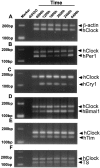Circadian expression of clock genes in human oral mucosa and skin: association with specific cell-cycle phases
- PMID: 11337377
- PMCID: PMC1891949
- DOI: 10.1016/S0002-9440(10)64135-1
Circadian expression of clock genes in human oral mucosa and skin: association with specific cell-cycle phases
Abstract
We studied the relative RNA expression of clock genes throughout one 24-hour period in biopsies obtained from the oral mucosa and skin from eight healthy diurnally active male study participants. We found that the human clock genes hClock, hTim, hPer1, hCry1, and hBmal1 are expressed in oral mucosa and skin, with a circadian profile consistent with that found in the suprachiasmatic nuclei and the peripheral tissues of rodents. hPer1, hCry1, and hBmal1 have a rhythmic expression, peaking early in the morning, in late afternoon, and at night, respectively, whereas hClock and hTim are not rhythmic. This is the first human study to show a circadian profile of expression for all five clock genes as documented in rodents, suggesting their functional importance in man. In concurrent oral mucosa biopsies, thymidylate synthase enzyme activity, a marker for DNA synthesis, had a circadian variation with peak activity in early afternoon, coinciding with the timing of S phase in our previous study on cell-cycle timing in human oral mucosa. The major peak in hPer1 expression occurs at the same time of day as the peak in G(1) phase in oral mucosa, suggesting a possible link between the circadian clock and the mammalian cell cycle.
Figures






References
-
- Pittendrigh CS: Temporal organization: reflections of a Darwinian clock-watcher. Annu Rev Physiol 1993, 55:16-54 - PubMed
-
- Weaver DR: The suprachiasmatic nucleus: a 25-year retrospective. J Biol Rhythms 1998, 13:100-112 - PubMed
-
- Dunlap JC: Molecular bases for circadian clocks. Cell 1999, 96:271-290 - PubMed
-
- Tei H, Okamura H, Shigeyoshi Y, Fukuhara C, Ozawa R, Hirose M, Sakaki Y: Circadian oscillation of a mammalian homologue of the Drosophila period gene. Nature 1997, 389:512-516 - PubMed
Publication types
MeSH terms
Substances
Grants and funding
LinkOut - more resources
Full Text Sources
Other Literature Sources
Molecular Biology Databases

